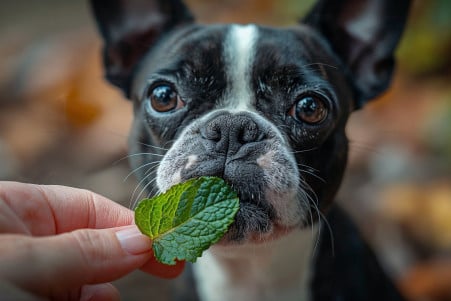Can Dogs Eat Peppermint? Examining the Risks and Benefits
22 March 2024 • Updated 20 March 2024

Peppermint-flavored treats are a popular choice for dog owners who want to include their pets in the holiday fun – but is peppermint actually safe for dogs? While small amounts of peppermint are not usually toxic to dogs, there are definitely some things to keep in mind. One of the biggest is that the menthol in peppermint can lead to gastrointestinal upset, including vomiting, diarrhea, and a loss of appetite, especially if it's ingested in large quantities.
To help you understand the potential risks and benefits of giving your dog peppermint, we've taken a look at the veterinary research that has been done on the compounds found in this aromatic herb.
Not only does this research highlight the potential dangers of giving your dog peppermint, but it also considers whether or not there are any benefits to giving your dog peppermint in the right amounts.
With the help of the experts, you'll have the information you need to decide if you want to give your dog peppermint-flavored treats in a way that's safe and healthy.
Can dogs eat peppermint?
Peppermint Candy and Concentrated Products: A Dangerous Treat for Dogs
Although fresh peppermint leaves can be given to dogs in moderation, peppermint candy and other concentrated peppermint products can be especially dangerous. Many peppermint candies contain xylitol, a sugar substitute that is highly toxic to dogs when ingested. Xylitol can cause a rapid and dangerous drop in blood sugar levels, potentially leading to liver failure and even death in severe cases, according to the Pet Poison Helpline.
If a dog ingests xylitol, it’s important to get them to a vet right away, as symptoms like vomiting, lethargy, loss of coordination and seizures can develop within 30 minutes of ingestion. Other concentrated peppermint products, including peppermint essential oils and extracts, can also cause a range of issues in dogs, including stomach upset, breathing problems, and other symptoms. Even the wrappers from peppermint candy can be dangerous, as they can cause gastrointestinal blockages if swallowed.
While peppermint itself may not be toxic in small amounts, the concentrated forms and added ingredients in many peppermint products make them unsafe for our canine companions. To be safe, it’s best to avoid these products and only give dogs fresh peppermint leaves in moderation.
Safe Ways to Feed Dogs Fresh Peppermint Leaves
Despite the potential dangers of fresh peppermint and spearmint leaves, there are some health benefits to feeding dogs small amounts of these herbs. According to Animal Wellness Magazine, mint leaves are full of vitamins, minerals, antioxidants, and fiber, all of which can help improve a dog's health. The Farmer's Dog adds that peppermint can help with digestive issues, while spearmint can help freshen breath and even work as a natural flea and tick repellent.
That said, it's important to use these herbs in moderation - BeChewy warns that eating too many peppermint leaves can lead to gastrointestinal issues like vomiting and diarrhea. They recommend feeding dogs just a few fresh or dried mint leaves a day, mixed in with their regular food. This is also the recommendation from Rover.com and Nom Nom.
While there are some benefits to feeding dogs fresh peppermint and spearmint in small amounts, it's important for dog owners to understand the potential toxicity of other mint species.
Toxic Dangers of Pennyroyal and Other Mint Varieties for Dogs
Although peppermint and spearmint are safe for dogs as long as they are given in moderation, the mint known as pennyroyal is extremely toxic and should not be given to dogs at all. According to Daily Paws, pennyroyal can cause dogs to develop liver damage, vomiting, weakness, and seizures.
Other mint plants, such as wintergreen, can be poisonous to dogs, leading to skin problems, digestive upset, and breathing issues, per Dr. Buzby's ToeGrips for Dogs. This means that dog owners need to make sure they know exactly which mints they are exposing their dogs to and talk to a vet if they have any questions so that they can be sure they are avoiding any toxic mints.
While fresh peppermint leaves can be given safely in small amounts, it's important for dog owners to understand that there are serious dangers associated with some other mint plants and mint-based products. That said, there are some essential oils that can be used around dogs as long as they are used in the right way.
Essential Oils That Are Safe for Dogs and Their Potential Uses
Although many essential oils are toxic to dogs, there are also several that are safe to use as long as they are used correctly. According to Forbes Advisor, some of the essential oils that are generally safe for dogs are lavender, chamomile, frankincense, and rosemary. The OH Blog also includes myrrh, ginger, and bergamot on the list of safe essential oils for dogs.
These oils can be used to promote relaxation, repel fleas and ticks, and support digestion, among other things, when used in moderation and under the guidance of a veterinarian, according to Wondercide. However, it is important to make sure that essential oils are diluted before using them and to avoid letting dogs ingest them or applying them directly to dogs' skin, according to PetMD.
Dog owners should always talk to a veterinarian or holistic practitioner before using essential oils with their dogs to make sure that they are using them in a way that is both safe and effective. When used correctly, some essential oils can be helpful, but it's important to use them responsibly and in moderation.
Safe Use and Moderation: What Dog Owners Should Know
Peppermint can be safe for dogs in small doses, but it’s important to use it in moderation to prevent negative side effects. Due to their potential toxicity, concentrated peppermint products such as candy, essential oils, and extracts should be avoided. In addition, the consumption of xylitol, a popular sweetener in peppermint candy, can lead to hypoglycemia and potential liver failure in dogs.
Fresh peppermint leaves can offer some benefits, such as helping with an upset stomach and improving bad breath, but they should only be given in small amounts and as an occasional treat. Dog owners need to be careful to recognize and steer clear of toxic mint plants, including pennyroyal, which can lead to serious side effects such as liver damage and seizures.
It’s important to talk to a vet and make sure to follow the appropriate safety measures before using peppermint or peppermint essential oils on dogs. While some peppermint products may be used in moderation and with care, it’s important to make sure that we’re always putting the health and safety of our dogs first.


